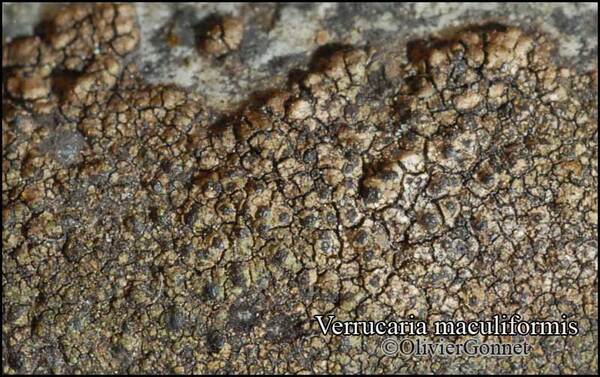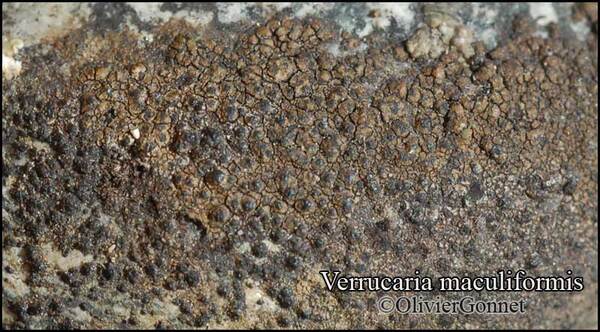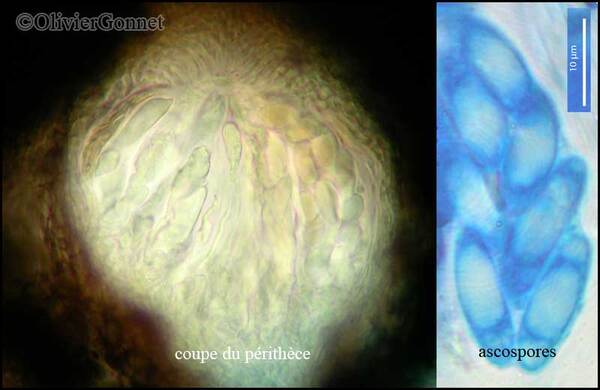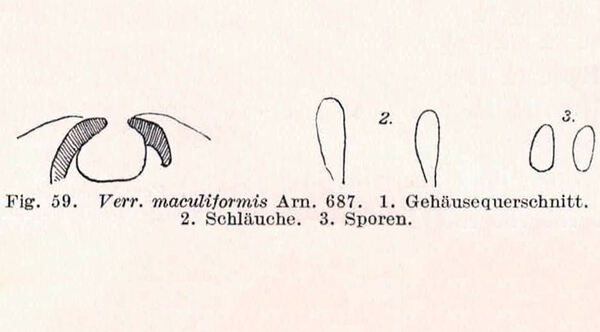Verrucaria maculiformis Kremp.
Flora, 41: 303, 1858, nom. illegit. non Hoffm.
Synonyms: Involucrothele maculiformis (Servít) Servít; Thelidium maculiforme Servít
Distribution: N - Ven, Lomb, Emil (Fariselli & al. 2020), Lig. C - Tosc. S - Camp.
Description: Thallus crustose, episubstratic, 100-150 μm thick, granular-areolate or fleck-like, subgelatinous when wet, medium to dark brown, glossy, smooth to rarely minutely uneven, sometimes delimited by an inconspicuous, brownish prothallus. Cortex thin, the cells with brownish-pigmented walls; algal layer continuous, 20-40 μm thick, the algal cells surrounded by paraplectenchymatous hyphae; medulla loose, paraplectenchymatous, with crystals visible under polarized light, without a black basal layer. Perithecia half to 1/4 immersed in the thallus, forming moderate, 0.15-0.25 mm wide projections, sometimes with a very thin thalline layer in lower part. Involucrellum limited to the upper half of exciple, conical, dark brown, 30-50 μm thick; exciple 0.15-0.2 mm across, the wall at first colourless, then brown; hamathecium of thick, unbranched, 15-20 μm long periphyses and periphysoids, interascal filaments absent; hymenial gel hemiamyloid, I+ red (I+ blue at very low concentrations of I), K/I+ blue. Asci 8-spored, clavate, I-, fissitunicate, the wall thickened above, with an ocular chamber, dehiscent by extrusion of an endotunica to form a delicate rostrum, Verrucaria-type. Ascospores 1-celled, hyaline, ellipsoid, 14-20 x 6-9 μm. Photobiont chlorococcoid. Spot tests: K-, C-, KC-, P-, UV-. Chemistry: without lichen substances.Note: this species seems to be most frequent in Western and Central Europe, on more or less calcareous pebbles or on bricks, especially in rather shaded situations. Most Italian records require confirmation. The name is illegitimate, being a later homonym of V. maculiformis Hoffm. (1796).
Growth form: Crustose
Substrata: rocks
Photobiont: green algae other than Trentepohlia
Reproductive strategy: mainly sexual
Poorly known taxon in need of further study
Commonnes-rarity: (info)
Alpine belt: absent
Subalpine belt: absent
Oromediterranean belt: absent
Montane belt: extremely rare
Submediterranean belt: very rare
Padanian area: absent
Humid submediterranean belt: very rare
Humid mediterranean belt: absent
Dry mediterranean belt: absent

Predictive model

Courtesy Danièle et Olivier Gonnet - Source: https://www.afl-lichenologie.fr/Photos_AFL/Photos_AFL_V/Verrucaria_maculiformis.htm
France, sur galet siliceux - Miribel-Jonage - 28/06/2011

Courtesy Danièle et Olivier Gonnet - Source: https://www.afl-lichenologie.fr/Photos_AFL/Photos_AFL_V/Verrucaria_maculiformis.htm
France, sur galet siliceux - Miribel-Jonage - 28/06/2011

Courtesy Danièle et Olivier Gonnet - Source: https://www.afl-lichenologie.fr/Photos_AFL/Photos_AFL_V/Verrucaria_maculiformis.htm
France, sur galet siliceux - Miribel-Jonage - 28/06/2011
Growth form: Crustose
Substrata: rocks
Photobiont: green algae other than Trentepohlia
Reproductive strategy: mainly sexual
Poorly known taxon in need of further study
Commonnes-rarity: (info)
Alpine belt: absent
Subalpine belt: absent
Oromediterranean belt: absent
Montane belt: extremely rare
Submediterranean belt: very rare
Padanian area: absent
Humid submediterranean belt: very rare
Humid mediterranean belt: absent
Dry mediterranean belt: absent

Predictive model

Courtesy Danièle et Olivier Gonnet - Source: https://www.afl-lichenologie.fr/Photos_AFL/Photos_AFL_V/Verrucaria_maculiformis.htm
France, sur galet siliceux - Miribel-Jonage - 28/06/2011

Courtesy Danièle et Olivier Gonnet - Source: https://www.afl-lichenologie.fr/Photos_AFL/Photos_AFL_V/Verrucaria_maculiformis.htm
France, sur galet siliceux - Miribel-Jonage - 28/06/2011

 INDEX FUNGORUM
INDEX FUNGORUM
 GBIF
GBIF
 DOLICHENS
DOLICHENS



